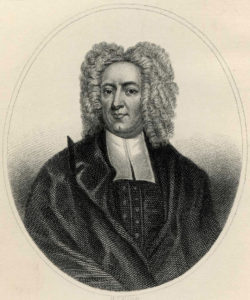Smallpox in Boston: Inoculation and the Revere Family

Cotton Mather
On February 16, 1764, Paul Revere reported to the board of selectmen in Boston that one of his children, either Deborah, Paul Jr., or Sarah, had contracted smallpox – an acute and highly contagious viral disease. Beginning with an intense fever, purple spots and pustules followed, usually leaving disfiguring pockmarks. Some smallpox victims also lost skin, developed deep ulcers, or experienced severe bleeding from the nose or mouth. Boston’s Dr. Zabdiel Boylston commented that some smallpox patients “looked black as the stock, others white as a sheet.” In some instances, fortunate survivors were still left both physically and mentally disabled. Approximately one out of every six persons who contracted smallpox in the 18th century died from the disease.
Boston’s selectmen were concerned that the distemper that had struck one of Revere’s children might spread. They strongly suggested that Revere take the child to the local “pesthouse.” Usually this was a vacant building which housed quarantined sufferers. Knowing that the pesthouse offered little chance of survival, Revere refused to give up his child to such a miserable situation. Unable to persuade him, the selectmen ordered that Revere and his family should be quarantined together with the child in their Fish Street home at the head of Clark’s Wharf in the North End. A white flag was hung outside as a sign that the house was under quarantine and an Irishman, Nicholas Murphy, was posted as a guard to see that no one entered or left the building.
By March 1764, smallpox had spread throughout the town. As a result, and in conjunction with his familial lockdown, Revere did no business for most of March and April. Many shops were abandoned or shut down between January and April, and over 1500 people fled the contagion by escaping into the countryside. With the epidemic reaching such a critical stage, the selectmen agreed to grant liberty to the residents to inoculate their families.
Inoculation in Boston was still a novelty in 1764. For the actual process, the inoculator would use a sharp toothpick to remove pus from a patient with “distinct” smallpox. The pus would then be collected in a quill which, when full, was emptied into a vial. Using a lancet, two incisions were made in the healthy patient’s arm just above the elbow. After cleaning the area, a drop of the pus was placed into each incision, after which the incisions were dressed with a “Diachylon Plaster” ointment. Cabbage or colewort leaves were recommended as a dressing. The patient was then kept indoors on a light diet. The smallpox would usually erupt on the sixth day, indicating that the procedure had been successful.
Dr. Benjamin Church, later a traitor to the Patriot cause, Dr. John Clarke, Paul Revere’s landlord at Clark’s Wharf, and Dr. Joseph Warren, Revere’s close political associate and friend, all performed inoculations during the 1764 epidemic. We do not know if Paul Revere arranged to have his family inoculated, or how many in his family were ultimately infected. Fortunately for the family and certainly against the odds, no one in the house died of smallpox. His child was spared, the family remained intact, and by June 1764 the worst of the epidemic was over.
While devastating to the town, Boston’s 1763-4 outbreak would have been far worse had it not been for New England’s pioneers in the inoculation field, Cotton Mather and Zabdiel Boylston. In April 1721, H.M.S. Sea Horse arrived in Boston from Saltertuda (probably Tortuga) with at least one infected individual on board. Upon landing, the man was removed to an empty house on shore. The selectmen immediately provided a nurse to watch over him with instructions not to leave the house. A red flag with the words “God have mercy” was hung over the door, and two guards were posted outside. Before long, it was reported that another individual had contracted the “distemper” and despite the initial isolation efforts, the trickle of cases turned into an epidemic. The newspapers reported new cases daily, and panic ensued.
Cotton Mather, Old North Meeting House’s pastor, became acquainted with inoculation through his slave Onesimus, who had been inoculated in Africa. Onesimus shared that the procedure had been carried out among his people, the Guarmantese, and showed Mather the scars on his arm. Having been interested in medicine since childhood, Mather investigated the technique further and confirmed Onesimus’s account by talking with other Africans in the North End. Mather realized, however, that he could not persuade the citizenry of Boston to accept smallpox inoculation solely on the authority of Africans. He sought to confirm the theoretical procedure through using European medical texts and came to be convinced of its efficacy, thus, becoming Boston’s most public-facing advocate.
In practice, Zabdiel Boylston was the first Boston physician willing to experiment with inoculation. Boylston himself had no need of inoculation as he had already contracted smallpox during the epidemic of 1702. So, he began by experimenting on his son in June 1721. Dr. Boylston also inoculated his 39-year-old slave Jack, as well as Jack’s two-year-old son Jacky. In his historical account “An Account of the Smallpox Inoculated in New England” Boylston recorded the experience of 247 persons he treated during that plague year of 1721. By his tabulations, he mostly inoculated Bostonians in the 15-40-year age range.
The 1721 epidemic killed around 844 of Boston’s 11,000 residents, or about 7.6% of the total citizenry. Of Boylston’s 247 inoculants, however, only 6 died for a 2.4% fatality rate. Their deaths were likely a result of Boylston’s understanding that if patients were even a little ill when inoculated, they might contract a more severe “confluent” case of smallpox which could be as lethal as contracting the disease in “the natural way” Most of Boylston’s subjects were healthy to begin with, however, and could weather the illness brought on through inoculation. Thus, Boylston proved that inoculation, though not completely without risk, could be done with an acceptable degree of safety and had a high survival rate.
Despite his results and Mather’s support, a severe reaction against inoculation swept through Boston. As Cotton Mather put it, people acted like “Idiots and Fanaticks” against the procedure, believing it to be against the natural order of the world and irresponsibly dangerous. At one point someone hurled a “grenado” through one of the windows of the Mather home. The bomb struck a beam but it failed to go off. Despite the push back, both men held firm in their stances and Bostonians eventually came around to the procedure’s value. This was fortunate indeed as wider acceptance of this kind of care likely helped the Reveres and their neighbors weather their run in with the pox four decades later. Yet still for the Reveres, the decision to shelter in place was balanced against their economic situation, but done so with their family’s comfort and overall safety in mind. Today we face similar challenges as we wait for modern day Mathers and Boylstons to develop treatments and vaccines.
Edward S Gault is an Interpreter at the Paul Revere House




